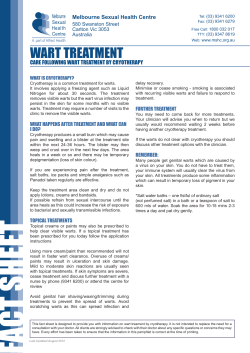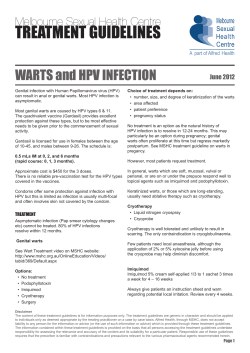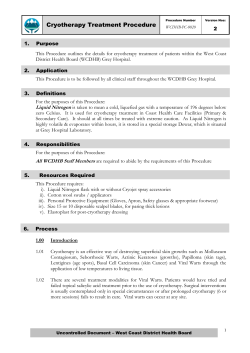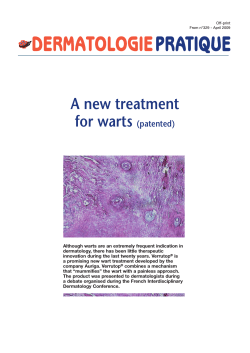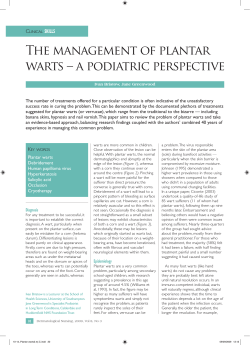
Oral zinc sulfate treatment for viral warts: An open-label study
Journal of Dermatology 2011; 38: 541–545 doi: 10.1111/j.1346-8138.2010.01056.x ORIGINAL ARTICLE Oral zinc sulfate treatment for viral warts: An open-label study Je-Ho MUN,1 Su-Han KIM,1 Do-Sang JUNG,1 Hyun-Chang KO,1 Byung-Soo KIM,1 Kyung-Sool KWON,1 Moon-Bum KIM1,2 1 Department of Dermatology, School of Medicine, Pusan National University, and 2Medical Research Institute, Pusan National University, Busan, Korea ABSTRACT Viral warts, which are caused by the human papilloma virus, are a common problem in dermatology. Various modalities have been used to treat warts, but none are uniformly effective or directly antiviral. Recent studies show that oral zinc sulfate could be effective in the treatment of viral warts. Thirty-one patients with multiple, non-genital viral warts were recruited in this open-label clinical study. The patients were treated with oral zinc sulfate (10 mg ⁄ kg to a maximum dose of 600 mg ⁄ day) for 2 months and followed up with assessments for the resolution of their warts and for any evidence of recurrence after treatment. Among the 31 patients, 18 patients showed low serum zinc levels (58%). Of 26 patients who completed the study (84%), 13 (50%) showed complete resolution of their warts after 2 months of treatment. Complete responders remained free of lesions at 6-month follow-up. No serious side-effects were reported apart from nausea (16%), mild gastric pain (3%) and itching sensation (3%). Oral zinc sulfate was found to be a good option in the treatment of viral warts, as it was safe and effective without important side-effects. Key words: efficacy, side-effect, treatment, viral warts, zinc sulfate. INTRODUCTION Viral warts are benign proliferations of the skin and mucosa that are caused by human papilloma virus (HPV) infection. Although they do not produce acute symptoms and regress spontaneously in two-thirds of lesions within 2 years,1 they often need treatment due to cosmetic concerns and the dread of autoinoculation. Primary treatment methods are physical destruction of warts such as electrodessication, laser therapy and cryotherapy. However, these treatments are not suitable for patients with multiple lesions or with fear of pain and scarring because they are associated with pain, risk of scarring and a significant recurrence rate. Therefore, oral immune-modifying agents might be a useful therapeutic alternative because they are painless and easy to administrate. H2-antagonists, especially cimetidine, are known to enhance immune responses and showed promising therapeutic outcomes with an estimated 48–81% response rate in open-label studies.2–5 However, subsequent randomized controlled trials (RCT) failed to show significant efficacy when cimetidine was compared with placebo or topical agents.6–8 Recently, oral zinc sulfate showed outstanding therapeutic efficacy with an estimated 62.5–86.9% complete response rate in three RCT and one double-blind prospective study in which it was compared with cimetidine.9–12 However, these reports are associated with controversy. One of the studies had a high dropout rate (nearly 50%)9 and most of the studies were carried out in the Middle East where zinc deficiency is presumed to be more prevalent secondary to their diet (high indigestion of cereal protein, rich in Correspondence: Moon-Bum Kim, M.D., Department of Dermatology, School of Medicine, Pusan National University, 305 Guduk-ro, Seo-gu, Busan 602-739, Korea. Email: drkmp@hanmail.net Received 21 February 2010; accepted 25 June 2010. 2010 Japanese Dermatological Association 541 J.-H. Mun et al. phytate, which inhibits zinc absorption, and low intake of animal protein), considerable loss of zinc due to excessive sweating in hot climates and blood loss due to hookworm infection.13 Moreover, one RCT recently revealed that there is no significant difference in clearance rates of viral warts between a zinc-treated group and a placebo group.14 Therefore, further studies are required to corroborate its therapeutic efficacy. Our study was designed to evaluate whether oral zinc sulfate is effective in patients with viral warts. common warts, three had plantar warts, and two had both common and plantar warts. Eighteen of 31 patients (58%) showed a low serum zinc level (<70 lg ⁄ 100 mL). The mean serum zinc level was 69.4 ± 17.6 lg ⁄ 100 mL (range, 33.3–118.8). None of the patients showed any signs or symptoms of zinc deficiency such as growth retardation, (a) METHODS Thirty-one patients with viral warts attending the dermatological clinic of Pusan National University Hospital were included in the study (11 males and 20 females; age range 6–54 years, mean 26). They were informed of the purpose of the study and the committee of ethics approved the study. All patients had multiple warts (from at least five to more than 200, mean 46) of at least 6 months’ duration. Most patients had been previously treated with topical agents, cryotherapy, lasers, topical immunotherapy and other modalities. We excluded patients who had high serum zinc levels (>250 lg ⁄ dL), hypocupremia, previous adverse effects after oral zinc sulfate, were concurrently using H2 antagonists or topical agents, or were pregnant. At the beginning of the study, a venous blood sample was taken from every subject for testing for serum zinc levels through atomic absorption spectrophotometry. Patients received oral zinc sulfate (10 mg ⁄ kg to a maximum dose of 600 mg ⁄ day) for 2 months and were reviewed at 2-week intervals. A ‘‘complete response’’ (CR) meant 100% clearing of all warts with no formation of new warts; otherwise, the subject was regarded a ‘‘non-responder’’ (NR). Patients were followed up to check for any recurrence until 6 months after the end of treatment. (b) RESULTS Of 31 subjects enrolled, 26 (84%) completed 2 months of therapy and evaluation. Six patients discontinued participation in the study secondary to noncompliance. Ages ranged 6–54 years (median, 25 years), and 10 subjects (38%) were under 18 years old. Fourteen had flat warts, seven had 542 Figure 1. Twenty-year-old woman with multiple flat warts on her face before (a) and after treatment (b) showing the resolution of flat warts. 2010 Japanese Dermatological Association 2010 Japanese Dermatological Association 50% N⁄A 16% 12% 78.1% 13% 76.9% 7.8% 86.9% 0% Duration of treatment in months Mean serum zinc level ± SD in patients (lg ⁄ 100 mL) Mean serum zinc level ± SD in healthy control group (lg ⁄ 100 mL) AG, complete response rate PG ⁄ CG, complete response rate AG, active group; CG, cimetidine treated group; N ⁄ A, not available; PG, placebo group; PR, partial response; SD, standard deviation. N⁄A 2 AG: 53.3 ± 9.7, PG: 58.04 ± 9.13 94.02 ± 38.11 62.5% 0% (PR: 44%) 70.97 ± 14.00 2 69.4 ± 17.6 2 AG: 102, PG: 103 N⁄A 3 N⁄A AG: 28.4, PG: N ⁄ A AG: 27.3, PG: N ⁄ A Mean duration of disease in months (range) Dose of oral zinc sulfate AG: 20 (4–50), PG: 20 (7–37) AG: 24 (12–120), PG: 20 (12–36) 10 mg ⁄ kg per day (maximum 600 mg) 2 AG: 62.5 ± 10.72, PG: 66.4 ± 11.55 87.8 ± 10.06 2 AG: 55.09 ± 10.07, PG: 56.63 ± 8.73 N⁄A 38.5 (6–120) N⁄A 26 (6–54) N⁄A AG: 17.6, PG: N ⁄ A AG: 15.9, PG: N ⁄ A 80 (40 vs 40) 43 (23 vs 20) No. of subjects (AG vs PG ⁄ CG) No. of subjects who completed study (AG vs PG ⁄ CG) Mean age in years (range) AG: 27.0 (7–63), CG: 22.1 (5–50) AG: 22.5 (12–60), CG: 21.8 (4–60) 31 26 Open-label Double-blind, placebo controlled 50 (25 vs 25) 46 (22 vs 24) Double-blind, placebo controlled N⁄A 55 (32 vs 23) Double-blind, placebo controlled 26 (13 vs 13) 26 (13 vs 13) Placebo-controlled Study design Oral zinc versus cimetidine treatment 18 (9 vs 9) 17 (8 vs 9) 14 12 10 11 9 Al-Gurairi et al.9 administrated oral zinc sulfate at a dose of 10 mg ⁄ kg up to 600 mg daily for 2 months in a placebo-controlled clinical trial involving 80 patients with viral warts (common, plantar and plain). Twentythree of 40 patients (58%) in the zinc-treated group and 20 out of 40 (50%) in the placebo-treated group completed the study. Complete clearance was reported for 87% of the treated group versus no clearance for the placebo group. Though this first study is a revolutionary report, it has two limitations: (i) the high dropout rate (nearly 50%); and (ii) not using an intention-to-treat analysis.16 After this first study, four other studies were performed to evaluate effectiveness of oral zinc sulfate (Table 1). Two placebocontrolled RCT showed remarkable CR rates: 76.9% and 78.1% in the treated group compared with 7.8% and 13% in the placebo group for 2 months treatment.10,11 Another randomized double-blind prospective study comparing the efficacy of oral zinc sulfate and cimetidine revealed a 62.5% CR in the Reference no. DISCUSSION Table 1. Reported studies on the efficacy of oral zinc sulfate for the treatment of viral warts delayed puberty, erectile dysfunction, diarrhea, alopecia, glossitis, nail dystrophy, hypogonadism (in males) and decreased immunity.15 Overall, 50% of patients had a CR. The CR rates according to the type of viral warts were as follows: 40% (6 ⁄ 14) for flat warts; 57% (4 ⁄ 7) for common warts; 33% (1 ⁄ 3) for plantar warts; and 100% (2 ⁄ 2) for the mixed type including common and plantar warts. The cumulative response rates according to duration of treatment were 15% (4 ⁄ 26) at 2 weeks after the onset of treatment, 35% (9 ⁄ 26) at 4 weeks, 42% (11 ⁄ 26) at 6 weeks and 50% (13 ⁄ 26) at 8 weeks. Younger patients had a better response than older patients. Of the 10 pediatric patients (<18 years), seven showed complete resolution (70%) and of 16 adults (>18 years), six achieved complete clearance (38%). Patients with CR were followed up until 6 months after the end of treatment and they were free of lesions. Clinical response in one patient is shown in Figure 1. No serious side-effects were reported except for nausea in five patients (16%), mild gastric pain in one patient (3%) and an itching sensation in one patient (3%). These side-effects were mild and transient and did not require the discontinuation of zinc sulfate. Our study Oral zinc sulfate treatment for viral warts 543 J.-H. Mun et al. zinc-treated group versus 0% in the cimetidine group.12 However, one recent double-blind RCT reported that the efficacy of oral zinc sulfate was not superior to placebo.14 Our study is the sixth report on oral zinc sulfate treatment for viral warts and shows a 50% CR rate. Weaknesses of this study are that there was no control group and it was not blind because we were unable to find a suitable placebo in order to carry out a double-blind RCT which is needed to confirm our results. Nevertheless, although ours is an open study, the success rate is appreciably greater than the reported cure rates for placebo treatments. Cure rates for warts associated with placebo treatments were reported to range 10–35%6,17–19 and CR rates for placebo treatments (Table 1) ranged 0–13%. The CR rate of our study is lower than in previous reports but a 50% CR is a substantial result because it indicates that half of patients suffering from viral warts can be cured. Our results show that younger patients and patients with common warts respond favorably. The CR rate was higher in pediatric patients (70%, 7 ⁄ 10) than in adult patients (38%, 6 ⁄ 16). CR rates according to the type of viral warts were 57% (4 ⁄ 7) for common warts, 100% (2 ⁄ 2) for the mixed type with both common and plantar warts, 40% (6 ⁄ 14) for flat warts and 33% (1 ⁄ 3) for plantar warts. In the present study, 58% patients showed a low serum zinc level. However, no one had any signs or symptoms of zinc deficiency. The mean serum zinc level was 69.4 lg ⁄ 100 mL which is slightly lower than the normal range but higher than the level of patients in the previous studies (Table 1). These reports revealed that serum zinc levels in patients with warts was statistically lower than the healthy control group and response to treatment was directly related to the increment in serum zinc levels after administration of study medications.9–11 In our study, as a control group, we checked the serum zinc level in 40 healthy individuals who were matched for age and sex and evaluated follow-up serum zinc levels at 1 month after completion of treatment in 10 patients (five in the CR group and five in the NR group). The mean serum zinc level in the healthy control group was 70.97 ± 14.0 lg ⁄ 100 mL (range, 49.4–108.5) and 22 of 40 (55%) individuals showed a low serum zinc level which was not notably different from data from patients with viral warts (58%). The follow-up serum 544 zinc change did not seem to be related to treatment outcome. The mean serum zinc level increased from 65.6 to 82.4 lg ⁄ 100 mL in five patients with CR and from 60.4 to 78.8 lg ⁄ 100 mL in five patients with NR. Because the serum zinc level can fluctuate widely and is a very poor reflection of total body zinc status unless it is very low, measurement of it is not very trustworthy.12,15,16 We think that different dietary customs according to ethnic groups could be another factor which affects the serum zinc level. Further studies are required to unravel these inconsistencies. Viral warts are caused by HPV which has several mechanisms for avoiding immune mechanisms.20 Thus, a method aimed at modulating the immune system and facilitating the production of cytokines can be a therapeutic option.10 Zinc is a trace element that is essential for the functioning of many enzymes and transcription factors. It is crucial for all highly proliferating cells in the human body, especially the immune system, and innate and acquired immunity can be compromised by zinc deficiency.13,21–23 Zinc has immunomodulatory effects that could counteract viral infections by having an effect on the synthesis of cytokines. In vitro, zinc induces the production of antiviral interferon (IFN)-a as well as IFN-c and it can potentiate the antiviral action of IFN-a.24–26 In addition, clearance of viral infections requires cytotoxic T lymphocytes, which are highly dependent on zinc.26 In vivo, not only oral zinc sulfate but also topical zinc oxide has shown therapeutic efficacy in the treatment of viral warts.27 Therefore, zinc can be a therapeutic option by modulating the immune system in a patient with viral warts. In our study, no significant adverse effects were reported except for nausea in five patients (16%), mild gastric pain in one patient (3%) and itching sensation in one patient (3%). These unwelcome adverse effects were mild and transient and did not require cessation of treatment. Nausea was a common sideeffect of oral zinc sulfate.9 Because we think that oral zinc sulfate has a metallic taste when mixed with water, we suggested that patients ingest zinc sulfate by dividing the total dose into three daily doses and take it with milk or yogurt when they experienced a metallic taste or nausea. This method relieved the side-effect in most patients. Our findings suggest that oral zinc sulfate is worth considering as a therapeutic option for the treatment 2010 Japanese Dermatological Association Oral zinc sulfate treatment for viral warts of viral warts; it is safe, effective and lacking important side-effects. REFERENCES 1 Massing AM, Epstein WL. Natural history of warts. A two-year study. Arch Dermatol 1963; 87: 306–310. 2 Glass AT, Solomon BA. Cimetidine therapy for recalcitrant warts in adults. Arch Dermatol 1996; 132: 680–682. 3 Orlow SJ, Paller A. Cimetidine therapy for multiple viral warts in children. J Am Acad Dermatol 1993; 28: 794– 796. 4 Fischer G, Rogers M. Cimetidine therapy for warts in children. J Am Acad Dermatol 1997; 37: 289–290. 5 Gooptu C, Higgins CR, James MP. Treatment of viral warts with cimetidine: an open-label study. Clin Exp Dermatol 2000; 25: 183–185. 6 Yilmaz E, Alpsoy E, Basaran E. Cimetidine therapy for warts: a placebo-controlled, double-blind study. J Am Acad Dermatol 1996; 34: 1005–1007. 7 Karabulut AA, Sahin S, Eksioglu M. Is cimetidine effective for nongenital warts: a double-blind, placebocontrolled study. Arch Dermatol 1997; 133: 533–534. 8 Rogers CJ, Gibney MD, Siegfried EC, Harrison BR, Glaser DA. Cimetidine therapy for recalcitrant warts in adults: is it any better than placebo? J Am Acad Dermatol 1999; 41: 123–127. 9 Al-Gurairi FT, Al-Waiz M, Sharquie KE. Oral zinc sulphate in the treatment of recalcitrant viral warts: randomized placebo-controlled clinical trial. Br J Dermatol 2002; 146: 423–431. 10 Sadighha A. Oral zinc sulphate in recalcitrant multiple viral warts: a pilot study. J Eur Acad Dermatol Venereol 2009; 23: 715–716. 11 Yaghoobi R, Sadighha A, Baktash D. Evaluation of oral zinc sulfate effect on recalcitrant multiple viral warts: a randomized placebo-controlled clinical trial. J Am Acad Dermatol 2009; 60: 706–708. 12 Stefani M, Bottino G, Fontenelle E, Azulay DR. [Efficacy comparison between cimetidine and zinc sulphate in the treatment of multiple and recalcitrant warts]. An Bras Dermatol 2009; 84: 23–29. 13 Prasad AS. Zinc in human health: effect of zinc on immune cells. Mol Med 2008; 14: 353–357. 2010 Japanese Dermatological Association 14 Lopez-Garcia DR, Gomez-Flores M, Arce-Mendoza AY, de la Fuente-Garcia A, Ocampo-Candiani J. Oral zinc sulfate for unresponsive cutaneous viral warts: too good to be true? A double-blind, randomized, placebocontrolled trial. Clin Exp Dermatol 2009; 34: e984– e985. 15 Saper RB, Rash R. Zinc: an essential micronutrient. Am Fam Physician 2009; 79: 768–772. 16 Gibbs S. Zinc sulphate for viral warts. Br J Dermatol 2003; 148: 1082–1083. 17 Spanos NP, Williams V, Gwynn MI. Effects of hypnotic, placebo, and salicylic acid treatments on wart regression. Psychosom Med 1990; 52: 109–114. 18 Labrecque M, Audet D, Latulippe LG, Drouin J. Homeopathic treatment of plantar warts. CMAJ 1992; 146: 1749–1753. 19 Bart BJ, Biglow J, Vance JC, Neveaux JL. Salicylic acid in karaya gum patch as a treatment for verruca vulgaris. J Am Acad Dermatol 1989; 20: 74–76. 20 Stanley M. Immune responses to human papillomavirus. Vaccine 2006; 1: S16–S22. 21 Fraker PJ, Jardieu P, Cook J. Zinc deficiency and immune function. Arch Dermatol 1987; 123: 1699– 1701. 22 Ibs KH, Rink L. Zinc-altered immune function. J Nutr 2003; 133: 1452S–1456S. 23 Kitamura H, Morikawa H, Kamon H et al. Toll-like receptor-mediated regulation of zinc homeostasis influences dendritic cell function. Nat Immunol 2006; 7: 971–977. 24 Cakman I, Kirchner H, Rink L. Zinc supplementation reconstitutes the production of interferon-alpha by leukocytes from elderly persons. J Interferon Cytokine Res 1997; 17: 469–472. 25 Berg K, Bolt G, Andersen H, Owen TC. Zinc potentiates the antiviral action of human IFN-alpha tenfold. J Interferon Cytokine Res 2001; 21: 471–474. 26 Overbeck S, Rink L, Haase H. Modulating the immune response by oral zinc supplementation: a single approach for multiple diseases. Arch Immunol Ther Exp (Warsz) 2008; 56: 15–30. 27 Khattar JA, Musharrafieh UM, Tamim H, Hamadeh GN. Topical zinc oxide vs. salicylic acid-lactic acid combination in the treatment of warts. Int J Dermatol 2007; 46: 427–430. 545
© Copyright 2025

